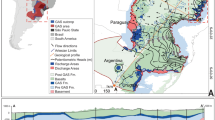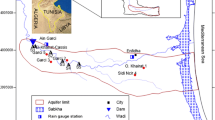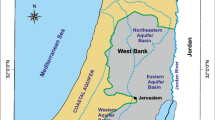Abstract
The groundwater constitutes the major water resource in the study area of the current paper that is Sfax region. The latter is located in the south of Tunisia where the climate is arid. In fact, the natural groundwater recharge of the region is deeply affected by the lack of precipitations which affects its natural groundwater recharge. The aim of the current paper is to define recharge potential zones and to estimate the rainfall recharge of the shallow groundwater. Henceforth, the potential recharge map was established, based on the basin characteristics using lithology, topography, slope, and stream network parameters. Recharge estimations were based on the numerical methods: the Estimation of Recharge in Overexploited Aquifers (Estimación de la Recarga en Acuíferos Sobreexplotados) (ERAS) numerical model, the Schoeller equation, the Fersi equations, and the Direction Générale des Ressources en Eaux (General Administration of Water resources) (DGRE) coefficients. As a matter of fact, applying the Fersi equations and the DGRE coefficients on the potential zones allowed the deduction of a new spatial repartition of both favorable and unfavorable recharge zones.















Similar content being viewed by others
Abbreviations
- PET:
-
Potential evapotranspiration
- WTF:
-
Water table fluctuation
- GIS:
-
Geographic information system
- DEM:
-
Digital elevation model
- R :
-
Recharge (mm/year)
- P :
-
Average of annual precipitations (mm/year)
- C1:
-
Average concentration of chloride from rainfall (mg/l)
- C2:
-
Average concentration of chloride from groundwater (mg/l)
- P i :
-
The annual rainfall (mm)
- Ri :
-
Annual recharge (mm)
- T i :
-
The average air temperature in (°C)
- β:
-
Dimensionless calibration parameter
- M :
-
Calibrated parameter
- N :
-
Calibrated parameter
- I1:
-
Efficient infiltration for moderate permeability (mm)
- I2:
-
Efficient infiltration for low permeability
References
Abdalla F (2012) Mapping of groundwater prospective zones using remote sensing and GIStechniques: A case study from the Central Eastern Desert, Egypt. J Afr Earth Sci 70(2012):8–17
Aguilera H, Murillo JM (2009) The effect of possible climate change on natural groundwater recharge based on a simple model: a study of four karstic aquifers in SE Spain. Environ Geol 57:963–974
Andreu JM, Delgado J, García-Sánchez E, Pulido-Bosch A, Bellot J, Chirino E, Ortiz de Urbina JM (2001) Caracterización del funcionamiento y la recarga del acuífero del Ventós-Castellar (Alicante). Rev Soc Geol Esp 14:247–254
Andreu JM, Alcalá FJ, Vallejos Á, Pulido-Bosch A (2011) Recharge to mountainous carbonated aquifers in SE Spain: Different approaches and new challenges. J Arid Environ 75(2011):1262–1270
Banton O, Bangoy LM (1997) Hydrogéologie: Multi-science environnementale des eaux souterraines. Université du Québec / AUPELF, Québec, p 460
Ben Brahim F (2006) Actualisation de l’etude hydrogeologique des nappes phreatiques d’el Hencha, djebeniana et el Amra : artographie, synthese, relation et gestion
Boughariou E, Bouri S, Khanfir H, Zarhloule Y (2013) Impacts of climate change on water resources in arid and semi-arid regions: Chaffar Sector, Eastern Tunisia. Desalin Water Treat 2013:1–12
Campbell SDG, Merritt JE, Dochartaigh BEÓ, Mansour MM, Hughes AG, Fordyce FM, Entwisle DC, Monaghan AA, Loughlin SC (2010) 3D geological models and their hydrogeological applications: supporting urban development: a case study in Glasgow–Clyde, UK. Z Dtsch Ges Geowiss 161(2):51–262
Carneiro JF, Boughriba M, Correia A, Zarhloule Y, Rimi A, El Houadi B (2009) Evaluation of climate change effects in a coastal aquifer in Morocco using a density-dependent numerical model. Environ Earth Sci 61(2009):241–252
Carrera-Hernandez JJ, Gaskin SJ (2008) Spatio-temporal analysis of potential aquifer recharge: Application to the Basin of Mexico. J Hydrol 353:228–246
Castany G (1982) Principes et méthodes de l’hydrogéologie. Université de Pierre et Marie Crue (Paris VI), Paris, p 233
Castrignanò A, Goovaerts P, Lulli L, Bragato G (2000) A geostatistical approach to estimate probability of occurrence of Tuber melanosporum in relation to some soil properties. Geoderma 98:95–113
Cobaner M, Yurtal R, Dogan A, Motez LH (2012) Three dimensional simulation of sea water intrusion in coastal aquifers: A case studying the Goksu Deltaic Plainn. J Hydrol 464–465(2012):262–208
CRDA Sfax, Le rapport annuel de l’année (2010) par Khanfir H. C.R.D.A de Sfax, Arrondissement des eaux, CRDA Sfax, the annual report for the year 2010 by H. Khanfir, CRDA
Dages C, Voltz M, Bsaibes A, Prévot L, Huttel O, Louchart X, Garnier F, Negro S (2009) Estimating the role of a ditch network in groundwater recharge in a Mediterranean catchment using a water balance approach. J Hydrol 375(2009):498–512
DASSI L (2004) Etude hydrogéologique, hydrochimique et isotopique du bassin de Sbeitla (Tunisie centrale) - Etude de la zone non saturée.2004 p-95
ESRI. Environmental Systems Research Institute (1997) The Arc/Info Version 7. 1 Software Package Documentation. ESRI, Redlands
Fogg GE, LaBolle EM, Weissman GS (1999) Groundwater vulnerability assessment: hydrologic perspective and example from Salinas Valley, California. Assessment of Non-point Source Pollution in the Vadose Zone. Geophysical Monograph, 108. American Geophysical Union, pp. 45–61
Freeze RA, Cherry JA (1979) Groundwater. Pub. Prentice-Hall, New Jersey
Gaura S, Chaharb BR, Graillot D (2011) Combined use of groundwater modeling and potential zone analysis for management of groundwater. Int J Appl Earth Obs Geoinformation 13(2011):127–139
GDEM (2014) http://gdem.ersdac.jspacesystems.or.jp/index.jsp
Ghayoumiana J, Saravib MM (2007) Application of GIS techniques to determine areas most suitable for artificial groundwater recharge in a coastal aquifer in southern Iran. J Asian Earth Sci 30(2):364–374
Gotkowitz M (2010) Wisconsin Geological and Natural History Survey Educational Series 50-2 | 2010
Guadagnini L, Farina M, Simoni M (2002) Geostatistical modelling of a heterogeneous alluvial aquifer by indicator variables. IAHS-AISH Publ 277:115–121
Hughes AG, Mansour MM, Robins NS (2008) Evaluation of distributed recharge in an upland semi-arid karst system: the West Bank Mountain Aquifer, Middle East. Hydrogeol J 16(5):845–854
Jackson CR, Meister R, Christel Prudhomme C (2011) Modelling the effects of climate change and its uncertainty on UK Chalk groundwater resources from an ensemble of global climate model projections. Journal of Hydrology, Volume 399 (1) – Mar 8, 2011
Jang CS, Chen SK, Kuo YM (2013) Applying indicator-based geostatistical approaches to determine potential zones of groundwater recharge based on borehole data. Catena 101(2013):178–187
Johnson NM, Dreiss SJ (1989) Hydrostratigraphic interpretation using indicator geostatistics. Water Resour Res 25(12):2501–2510
Kumar B, Kumar U (2011) Ground water recharge zonation mapping and modeling using Geomatics techniques. Int J Environ Sci 1(7):2011
Lerner DN, Isaar AS, Simmers I (1990) Groundwater recharge: a guide to understanding and estimating natural recharge IAH International Contributions to Hydrogeology, vol 8. Verlag Heinz Heise, Hannover
Mansour MM, Hughes AG (2004) User’s manual for the distributed recharge model ZOODRM. British Geological Survey Internal Report, IR/04/150
Masciopinto C (2013) Management of aquifer recharge in Lebanon by removing seawater intrusion from coastal aquifers. J Environ Manag 130:306e312
MMA (2000) Libro blanco del agua en España. Dirección General de Obras Hidráulicas y Calidad del Agua e Ministerio de Medio. MMA, Madrid
Morris DA, Johnson AI (1967) Summary of hydrologic and physical properties of rock and soil Banton, 1997 et Castany, 1982materials. U.S. Geological Survey Water Supply Paper 42
Murillo JM, Roncero FJ (2005) Natural recharge and simulation of the management using the model “ERAS”. Application to the Peñarrubia aquifer (Alicante). Bol Geol Min 116:97–112
Piao S, Ciais P, Huang Y, Shen Z, Peng S, Li J, Zhou L, Liu H, Ma Y, Ding Y, Friedlingstein P, Liu C, Tan K, Yu Y, Zhang T, Fang J (2010) The impacts of climate change on water resources and agriculture in China. Nature 467(2010):43–51
Pohlmann K, Hassan A, Chapman J (2000) Description of hydrogeologic heterogeneity and evaluation of radionuclide transport at an underground nuclear test. J Contam Hydrol 44(3):353–386
Ragab R, Bromley J, Dörflinger G, Katsikides S (2010) IHMS—integrated hydrological modelling system. Part 2. Application of linked unsaturated, DiCaSM and saturated zone, MODFLOW models on Kouris and Akrotiri catchments in Cyprus. Hydrol Process 24:2681–2692
Rahman MA, Rusteberg B, Gogu RC, Ferreira JPL, Sauter M (2012) A new spatial multi-criteria decision support tool for site selection for implementation of managed aquifer recharge. J Environ Manag 99(2012):61–75
Saidi S, Bouri S, Ben Dhia H (2010) Groundwater vulnerability and risk mapping of the Hajeb-jelma aquifer (Central Tunisia) using a GIS-based DRASTIC model. Environ Earth Sci 59:1579–1588
Scanlon BR, Healy RW, Cook PG (2002) Choosing appropriate techniques for quantifying groundwater recharge. Hydrogeol J 10:18–39
Sikdar PK, Chakraborty S, Enakshi A, Paul PK (2004) Land use/land cover changes and groundwater potential zoning in and around Raniganj coal mining area, Bardhaman District, West Bengal—a GIS and remote sensing approach. J Spat Hydrol 4:1–24
Singh RD, Kumar CP (2010) Impact of Climate Change on Groundwater Resources. National Institute of Hydrology, Roorkee, Uttarakhand, 2010
Smida H (2003) Apport des Systemes d'Informations Geographiques pour l'Etude et la Gestion des Ressources en Eau: Application pour la Nappe de Chaffar – Sfax 2003
Smida H (2008) Apports des Systèmes d’Informations Géographiques (SIG) pour une approche intégrée dans l’étude et la gestion des ressources en eau des systèmes aquifères de la région de Sidi Bouzid (Tunisie centrale)
Sophocleous MA (1991) Combining the soil water balance and water table fluctuation methods to estimate natural groundwater recharge: Practical aspects. J Hydrol 124:229–241
Trabelsi R (2008) Contribution à l’étude de la salinisation des nappes Phréatiques côtières. Cas du système de Sfax-Mahdia
Trabelsi R, Zaïri M, Smida H, Ben Dhia H (2005) Salinisation des nappes côtières: cas de la nappe nord du Sahel de Sfax, Tunisie. Geoscience 337:515–524
Trevisani S, Fabbri P (2010) Geostatistical modeling of a heterogeneous site bordering the Venice lagoon, Italy. Ground Water 48(4):614–623
Tweed S, Leblanc M, Cartwright I, Guillaume FG, Leduc C (2011) Arid zone groundwater recharge and salinisation processes; an example from the Lake Eyre Basin, Australia. J Hydrol 408(2011):257–275
Voogd H (1983) Multi-Ctiteria Evaluation for Urban and Regional Planning. Pion, London
Woldeamlak ST, Batelaan O, De Smedt F (2007) Effects of climate change on the groundwater system in the Grote-Nete catchment, Belgium. Hydrogeol J 15(2007):891–901
Author information
Authors and Affiliations
Corresponding author
Rights and permissions
About this article
Cite this article
Boughariou, E., Saidi, S., Barkaoui, A.E. et al. Mapping recharge potential zones and natural recharge calculation: study case in Sfax region. Arab J Geosci 8, 5203–5221 (2015). https://doi.org/10.1007/s12517-014-1512-x
Received:
Accepted:
Published:
Issue Date:
DOI: https://doi.org/10.1007/s12517-014-1512-x




